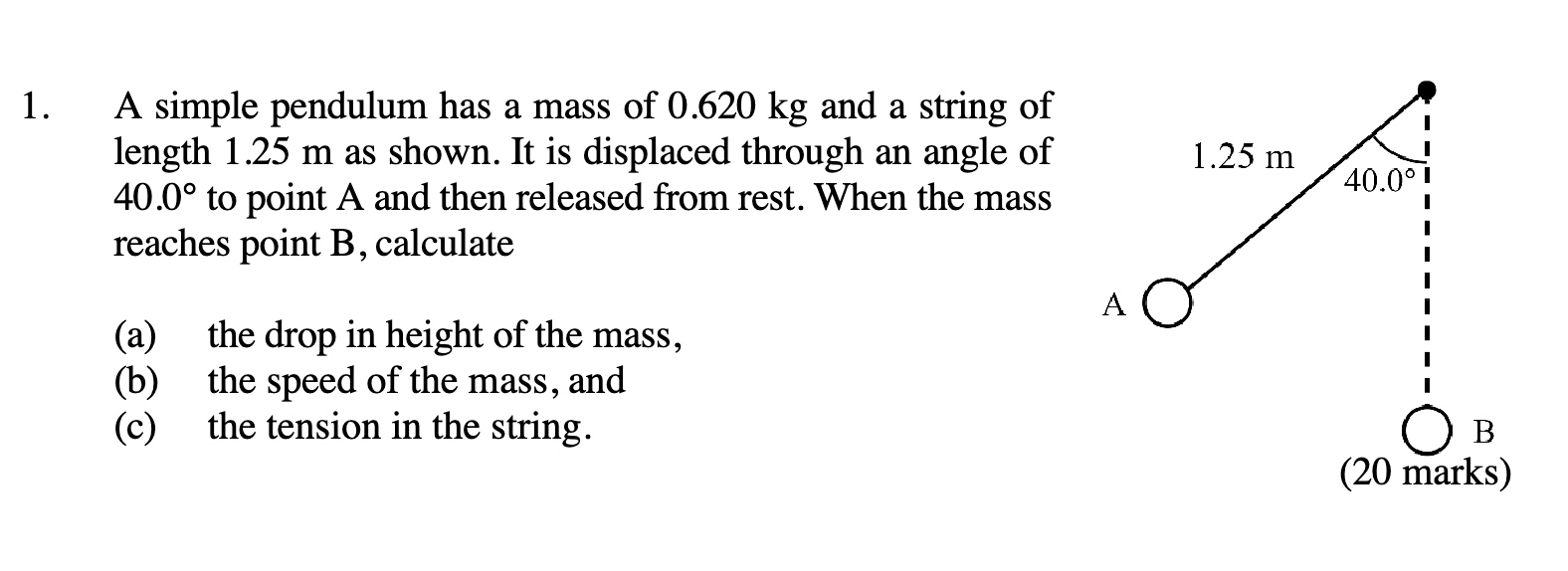A simple pendulum has a mass of 0.620 kg and a string of length 1.25 m. It is displaced through an angle of 40.0 degrees to point A and then released from rest. When the mass reach... A simple pendulum has a mass of 0.620 kg and a string of length 1.25 m. It is displaced through an angle of 40.0 degrees to point A and then released from rest. When the mass reaches point B, calculate: (a) the drop in height of the mass, (b) the speed of the mass, and (c) the tension in the string.

Understand the Problem
The problem describes a simple pendulum with a given mass and length, displaced at a certain angle and released. It asks to calculate: (a) the drop in height of the mass, (b) the speed of the mass at the lowest point, and (c) the tension in the string at the lowest point.
Answer
(a) $0.292 \text{ m}$ (b) $2.39 \text{ m/s}$ (c) $8.92 \text{ N}$
Answer for screen readers
(a) The drop in height is $0.292 \text{ m}$. (b) The speed of the mass at point B is $2.39 \text{ m/s}$. (c) The tension in the string at point B is $8.92 \text{ N}$.
Steps to Solve
- Calculate the vertical height at point A
We can calculate the vertical height at point A using trigonometry: $$h_A = L \cos(\theta)$$ where $L$ is the length of the string and $\theta$ is the angle. $L = 1.25 m$ and $\theta = 40.0^\circ$, therefore: $$h_A = 1.25 \times \cos(40.0^\circ) = 0.95755 \text{ m}$$
- Calculate the drop in height
The drop in height is the difference between the length of the string and the vertical height at point A:
$$ \Delta h = L - h_A$$ $$ \Delta h = 1.25 - 0.95755 = 0.29245 \text{ m} $$
- Calculate the speed at point B using conservation of energy
The potential energy at point A is converted to kinetic energy at point B. $$ mgh = \frac{1}{2}mv^2 $$ $$ v = \sqrt{2gh} = \sqrt{2 \times 9.8 \times 0.29245} = \sqrt{5.732} = 2.394 \text{ m/s} $$
- Calculate the tension in the string at point B
At point B, the tension in the string provides the centripetal force and balances the weight of the mass. $$T - mg = \frac{mv^2}{L}$$ Therefore, the tension $T$ is: $$T = mg + \frac{mv^2}{L}$$ $$T = (0.620 \times 9.8) + \frac{0.620 \times (2.394)^2}{1.25} = 6.076 + \frac{3.549}{1.25}= 6.076 + 2.839 = 8.915 \text{ N}$$
(a) The drop in height is $0.292 \text{ m}$. (b) The speed of the mass at point B is $2.39 \text{ m/s}$. (c) The tension in the string at point B is $8.92 \text{ N}$.
More Information
The problem demonstrates the conversion of potential energy to kinetic energy in a simple pendulum and the forces acting on the mass at the lowest point of its swing.
Tips
A common mistake is to forget to convert the angle from degrees to radians when using trigonometric functions. Another common mistake is incorrectly applying energy conservation principles. Finally, students often struggle with understanding the forces at the bottom of the swing.
AI-generated content may contain errors. Please verify critical information